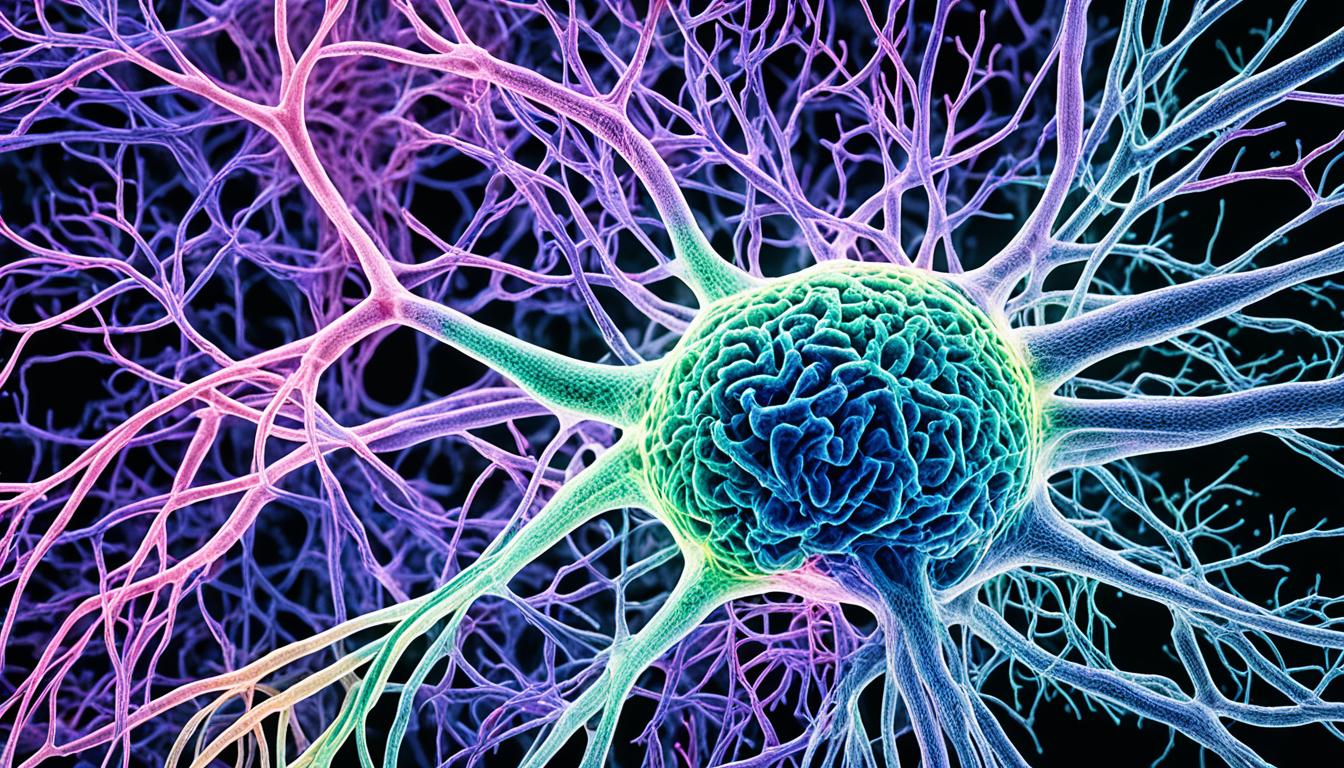Neurilemmoma, or schwannoma, is a tumor from Schwann cells in the nerves. It can be benign or malignant. It usually affects people aged 50 to 60, although kids can get them too. The exact cause isn’t known, but they may link to genetic issues like neurofibromatosis 2. Schwannomas can grow in many nerve areas, like the vestibular nerve or the brachial plexus nerves.
The main type is vestibular schwannoma, impacting the brain-inner ear nerve. Symptoms vary by tumor location and size. They can cause pain, weakness, or affect the senses. Doctors use MRI scans for diagnosis.
Key Takeaways:
- Neurilemmoma, also known as schwannoma, is a tumor that develops from the Schwann cells in the peripheral nervous system or nerve roots.
- These tumors are usually benign but can sometimes be malignant.
- Schwannomas most commonly affect people between the ages of 50 and 60.
- The exact cause of schwannomas is unknown, but they can be associated with genetic conditions such as neurofibromatosis 2.
- Symptoms of schwannomas can include pain, weakness, swelling, neurological disorders, and sensory abnormalities.
What is a Schwannoma?
A schwannoma is a growth that starts in Schwann cells of the nerve system. These cells help nerve signals move and protect nerves. Schwannomas usually grow slowly and affect different nerves in the body. They can show up on nerves like the vestibular, sciatic, brachial plexus, and sacral plexus.
Most schwannomas are not cancer, but some can turn out to be. Almost always, there’s just one tumor in 90% of cases.
The main reasons for schwannomas are still unclear. They might just happen without a clear cause. Or, they could be linked to genetic issues like neurofibromatosis 2. This condition leads to non-cancerous lumps in the nervous system.
Vestibular Schwannoma: A Common Type
Vestibular schwannoma, growing on the vestibular nerve, is the most usual. This nerve connects the brain to the inner ear, aiding in balance and hearing. As a vestibular schwannoma grows, it can cause hearing problems, ear ringing, and unsteadiness.
Now and then, schwannomas are cancerous and known as soft tissue sarcomas. If malignant, they can spread, causing more health issues.
| Type of Schwannoma | Location |
|---|---|
| Vestibular Schwannoma | Vestibular nerve (connects brain to inner ear) |
| Sciatic Schwannoma | Sciatic nerve (runs from lower back to the feet) |
| Brachial Plexus Schwannoma | Brachial plexus nerves (supply the arms and shoulders) |
| Sacral Plexus Schwannoma | Sacral plexus nerves (supply the lower back and legs) |
Symptoms and Diagnosis of Neurilemmoma
Neurilemmoma, or schwannoma, can show different symptoms based on its location and size. Common signs include:
- Pain: It can cause pain around the area of the affected nerve.
- Weakness: It might lead to general weakness by impacting nerve function.
- Swelling: Swelling where the tumor is can happen.
- Neurological disorders: It can result in disorders like numbness, tingling, or muscle control issues.
- Sensory abnormalities: Certain schwannomas might bring on sensory changes. This could be seeing, tasting, or feeling differently, or having facial sensitivity.
Vestibular schwannoma, for example, affects balance and hearing nerves in the inner ear. This can lead to tinnitus, hearing loss, and feeling off balance.
To spot neurilemmoma, doctors often turn to MRI scans. These tests show the tumor’s details, like size and where it is. They’re reliable in finding small tumors too.
Sometimes, a biopsy is done to be sure of the diagnosis. But, it might not always be needed. An MRI’s look can often tell if it’s a neurilemmoma.
Stem Cell Therapy for Neurilemmoma
Stem cell therapy is a new treatment for neurilemmoma, or schwannoma. It’s in the field of regenerative medicine. This kind of treatment aims to fix or change damaged tissues with stem cells. In the case of schwannomas, it helps make Schwann cells to replace the damaged ones.
Studies with stem cells have shown they can stop tumor growth and help nerves grow back. This is offering hope for new treatments. Right now, doctors are testing how safe and helpful stem cell therapy is for schwannomas in clinical trials. It’s still new, but it’s a hopeful way to treat this condition.
Thinking about treatment for neurilemmoma? It’s good to talk to a doctor or see if there are trials you can join. They’ll give you details on how well stem cell therapy might work for you. By keeping up with new treatments like stem cell therapy, things are looking up for people with neurilemmoma. The goal is to make life better.

